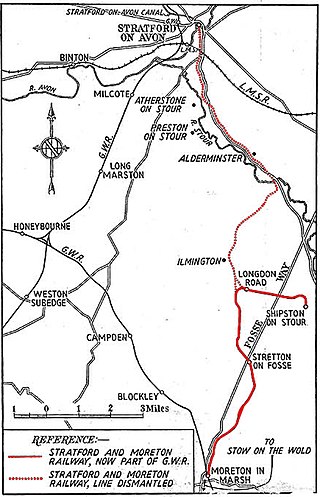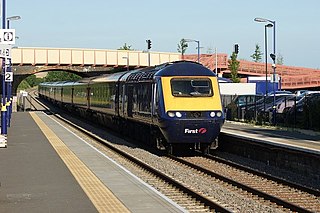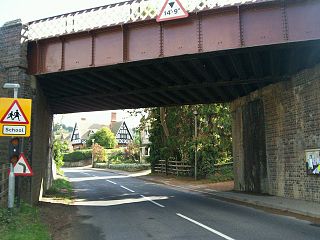
Gloucestershire is a county in South West England. The county comprises part of the Cotswold Hills, part of the flat fertile valley of the River Severn and the entire Forest of Dean.

The Settle–Carlisle line is a 73-mile-long (117 km) main railway line in northern England. The route, which crosses the remote, scenic regions of the Yorkshire Dales and the North Pennines, runs between Settle Junction, on the Leeds–Morecambe line, and Carlisle, near the English-Scottish borders. The historic line was constructed in the 1870s and has several notable tunnels and viaducts such as the imposing Ribblehead.

The Gloucestershire Warwickshire Steam Railway is a volunteer-run heritage railway which runs along the Gloucestershire/Worcestershire border of the Cotswolds, England.

The Stratford and Moreton Tramway was a 16-mile (25-km) long horse-drawn wagonway which ran from the canal basin at Stratford-upon-Avon in Warwickshire to Moreton-in-Marsh in Gloucestershire, with a branch to Shipston-on-Stour. The main line opened in 1826, whilst the branch to Shipston opened in 1836

Cheltenham Race Course railway station serves Cheltenham Racecourse on the outskirts of Cheltenham, Gloucestershire, England.

Winchcombe railway station is a heritage railway station which serves the town of Winchcombe in Gloucestershire, England. The stations itself is actually located in the nearby village of Greet. It is located on the Honeybourne Line which linked Cheltenham and Stratford-upon-Avon and which was opened by the Great Western Railway in 1906. The station closed to passengers in 1960, although the line itself remained open for freight and diversionary use until 1976, when a freight train derailed near Winchcombe and damaged the track.

Toddington railway station serves the village of Toddington in Gloucestershire, England. Since 1984 it has been the main base of operations for the heritage Gloucestershire Warwickshire Railway.

Honeybourne railway station serves the village of Honeybourne in Worcestershire, England. Opened in 1853, it is on the Cotswold Line and was formerly a busy junction with five platform faces, also serving trains on the Great Western Railway's Honeybourne Line between Cheltenham Spa and Stratford-upon-Avon, which formed part of a strategic route between the West Midlands and the West of England.
The Cheltenham and Great Western Union Railway was a railway company intended to link Cheltenham, Gloucester and Swindon, in England. It was authorised in 1836 but it found it very hard to raise money for the construction, and it opened only a part of its line, between Swindon and Cirencester, in 1841. It sold its business to the Great Western Railway, which quickly built the line through to Gloucester in 1845 and Cheltenham in 1847; part of that route was shared with other companies.

Stonehouse railway station, also known as Stroudwater station after the nearby canal, was a station in Stonehouse, England, on the Bristol and Gloucester Railway between Haresfield and Frocester.

Chambers Crossing Halt railway station was a timber-framed railway halt on the Stratford-upon-Avon to Cheltenham section of the Honeybourne Line. The station was located two miles south-west of Stratford upon Avon. The site of the station is now part of the Stratford greenway and may in future form part of the Gloucestershire Warwickshire Railway's northern extension from Toddington.

Cheltenham Spa Malvern Road railway station was a station in the town of Cheltenham.

Broadway railway station is a railway station on the heritage Gloucestershire Warwickshire Railway in the town of Broadway in Worcestershire, England.
Laverton Halt railway station was a halt on the Honeybourne Line from Honeybourne to Cheltenham which served the hamlet of Laverton in Gloucestershire between 1905 and 1960.

Hayles Abbey Halt railway station is a halt opened by the Great Western Railway on the Honeybourne Line from Honeybourne to Cheltenham which served the hamlet of Hailes in Gloucestershire, as well as the nearby Hailes Abbey, between 1928 and 1960. The line through the site of the station was reinstated in 1985 and opened in 1987 by the Gloucestershire Warwickshire Railway, although for many years no new halt was provided. The halt was eventually reopened on 5 June 2017 after being rebuilt by volunteers. Unlike the original, however, it only has a single platform. It lies between Toddington and Winchcombe stations.

Gretton Halt railway station was a halt opened by the Great Western Railway on the Honeybourne Line from Honeybourne to Cheltenham which served the small village of Gretton in Gloucestershire between 1906 and 1960. The line through the site of the station was reinstated in 1997 by the Gloucestershire Warwickshire Railway, although no new halt was provided.

Weston-sub-Edge railway station is a disused station on the Honeybourne Line from Stratford-upon-Avon to Cheltenham which served the village of Weston-sub-Edge in Gloucestershire between 1904 and 1960.

During the twenty-four hours before Friday 20 November 2009, rainfall of over 300 mm (12 in) was recorded in Cumbria. Flooding along the Borrowdale and Derwent Valley meant that some areas were up to 8 feet (2.4 m) deep in water. The surge of water off the fells of the Lake District which flowed into Workington down the River Derwent washed away a road bridge and a footbridge. PC Bill Barker was killed when Northside Bridge collapsed. The cemetery at Camerton, historically the burial ground for the community of Seaton, was badly damaged with many gravestones being damaged or upturned.

Dinting Viaduct is a 19th-century railway viaduct in Glossopdale in Derbyshire, England, that carries the Glossop Line over a valley at the village of Dinting. It crosses the Glossop Brook and the A57 road between Manchester and Sheffield.

Spon End Viaduct is a railway bridge which spans the River Sherbourne in Spon End, just west of the city centre of Coventry in central England.



















